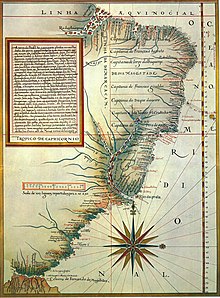Portuguese colonization of the Americas
[1] To that end, in 1499 and 1500, the Portuguese mariner João Fernandes Lavrador visited the northeast Atlantic coast and Greenland, which accounts for the appearance of "Labrador" on topographical maps of the period.
[2] Subsequently, in 1501 and 1502, the Corte-Real brothers explored and charted Greenland and what is today the Canadian province of Newfoundland and Labrador, claiming these lands as part of the Portuguese Empire.
Fragmentary evidence also suggests a previous expedition in 1473 by João Vaz Corte-Real, their father, with other Europeans, to Terra Nova do Bacalhau (New Land of the Codfish) in North America.
[2][3] The possible voyage of 1473 and several other possible pre-Columbian expeditions to North America in the 15th century, mostly from the Azores in the case of the Portuguese (included in donation royal letters), remain matters of great controversy for scholars.
Nonetheless, the Portuguese-founded towns of Portugal Cove-St. Philip's, St. Peter's, St. John's, Conception Bay and surrounding areas of east Canada remain important as a cultural region, even today.
[4] In April 1500, the second Portuguese India Armada, headed by Pedro Álvares Cabral, with a crew of expert captains, including Bartolomeu Dias and Nicolau Coelho, encountered the Brazilian coast as it swung westward in the Atlantic while performing a large "volta do mar" to avoid becalming in the Gulf of Guinea.
It has also been suggested that Duarte Pacheco Pereira may have discovered the coasts of Brazil in 1498, possible its northeast, but the exact area of the expedition and the explored regions remain unclear.
This seems controversial, since he changed part of his description in the subsequent letter (stating that around 32° S, they made a shift to open sea, to south-southeast), maintaining, however, that they reached a similar 50° S latitude.
His last two voyages to the east and southern east coasts of South America, by Portugal, especially the expedition of 1501–1502 to Brazil and beyond, and its meeting with Cabral's ships and men (who had touched the South American, African and Asian continents) on the African coast, at Bezeguiche (the bay of Dakar, Senegal), listening the accounts of its sailors (then returning to Portugal), were the most decisive for his "New World" hypothesis.
Permanent habitation in Brazil did not begin until São Vicente was founded in 1532 by Martim Afonso de Sousa, although temporary trading posts were established earlier to collect brazilwood, used as a dye.
From 1565 through 1567, Mem de Sá, the third Governor General of Brazil, successfully destroyed a ten-year-old French colony called France Antarctique, at Guanabara Bay.
To such an extent, that, for instance, for the Portuguese town of Póvoa de Varzim, most of its seafarers dying abroad, most of the deaths occurred in the Route of the Antilles, in the West Indies.
At the turn of the 17th century, with the union with Castile, the Spanish kings favored the free movement of the people, and other lands of the New World, such as Peru and the Gulf of Mexico, were open to the Portuguese merchants.


